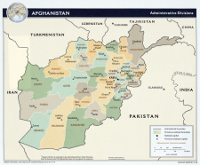Afghan and Coalition special operations forces killed and captured dozens of insurgents during a raid that targeted the Islamic Movement of Uzbekistan's top leader in the north.
 |
Map of Afghanistan's provinces. Click map to view larger |
The raid, which the International Security Assistance Force said was "led by more than 50 Afghan security members," took place in the Kishim district of the remote province of Badakhshan.
ISAF did not state how many insurgents were killed or captured, but the provincial spokesman for Badakhshan told Xinhua that 21 fighters were killed and nine more were captured. Two "group commanders" named Mullah Abadullah and Mullah Shir Mohammad were among those captured. "Roadside bomb making materials and multiple weapons were seized" during the raid, ISAF said in a press release.
The target of the raid was "northern Afghanistan's senior IMU leader, who facilitates suicide and roadside bomb attacks against Afghan security forces," ISAF stated. "The leader is a facilitator for IMU insurgents and senior leaders in Kabul and Ghazni, as well as, a coordinator for logistical and personnel movements for fighters throughout northern Afghanistan."
ISAF and Afghan forces captured the IMU's previous top commander in Afghanistan during a raid in Kunduz province in April 2011. He served as "a key conduit between the senior IMU leadership in Pakistan and senior Taliban leadership in Afghanistan," and aided in suicide, IED, and other attacks by the IMU in the north. He was freed from a Pakistani jail in 2010 and immediately returned to lead forces in Afghanistan [see LWJ report, ISAF captures Islamic Movement of Uzbekistan's top commander for Afghanistan].
Background on terrorist havens in the north
Earlier this year, ISAF identified several locations of safe havens and training camps in the north for the Taliban and the allied Islamic Movement of Uzbekistan. Both terror groups maintain a strong presence in the northern Afghan provinces of Badakhshan, Baghlan, Balkh, Faryab, Jawzjan, Kunduz, Samangan, Sar-i-Pul, and Takhar, and have established suicide and military training camps in the north over the past several years. As the two groups expand their presence in the region, top leaders of the Islamic Movement of Uzbekistan have integrated into the Taliban's shadow government in the northern provinces.
ISAF has identified the presence of suicide camps in Sar-i-Pul and Samangan provinces. On March 22, a special operations team captured an IMU commander who ran camps in Samangan. In addition, several other commanders who aid in suicide attacks have been targeted in the north.
The IMU has established camps in Kunduz province, a Taliban commander from Baghlan named Mustafa told the Asia Times earlier this year. The Taliban commander said that jihadis from Central Asia, including "Chechnya, Uzbekistan, Tajikistan, and Russia," make up a significant portion of the fighters in the the Afghan north and that they are setting their sights on the neighboring country of Uzbekistan.
"I can tell you that there is an active connection between the Central Asian command and the Taliban in northern Afghanistan and they often join us, but how they connect, this is beyond my level," Mustafa told Asia Times. "Our superior commanders are in touch with their counterparts in Central Asia and if somebody arrives in Afghanistan or goes to Central Asia from Afghanistan, it is arranged at a senior leadership level."
The Islamic Movement of Uzbekistan and the Islamic Jihad Group, an IMU splinter faction, are also known to operate in the southeastern Afghan provinces of Khost, Paktia, Paktika, Ghazni, and Zabul. The two groups work with the al Qaeda-linked Haqqani Network [see LWJ report, ISAF detains senior Haqqani Network leader linked to the IMU].
Background on the IMU in Pakistan
The IMU's leadership cadre is based in Pakistan's Taliban-controlled tribal agency of North Waziristan, and operates primarily along the Afghan-Pakistani border and in northern Afghanistan. According to one estimate, more than 3,000 Uzbeks and other Central Asian fighters are sheltering in North Waziristan.
The US ramped up airstrikes against the terror groups in North Waziristan between September 2010 and January 2011. Many of the strikes targeted cells run by the Islamic Jihad Group, which were plotting to conduct Mumbai-styled terror assaults in Europe. A Sept. 8 strike killed an IJG commander known as Qureshi, who specialized in training Germans to conduct attacks in their home country.
In South Waziristan, the IMU's former leader, Tahir Yuldashev, was killed in a US Predator airstrike in September 2009. Yuldashev sat on al Qaeda's top council, the Shura Majlis. He has been replaced by Abu Usman Adil.
Islamic Movement of Uzbekistan fighters often serve as bodyguards for top Pakistani Taliban and al Qaeda leaders. The IMU fights alongside the Taliban in Pakistan and Afghanistan, and has stepped up attacks in Central Asian countries as well.
Δεν υπάρχουν σχόλια:
Δημοσίευση σχολίου